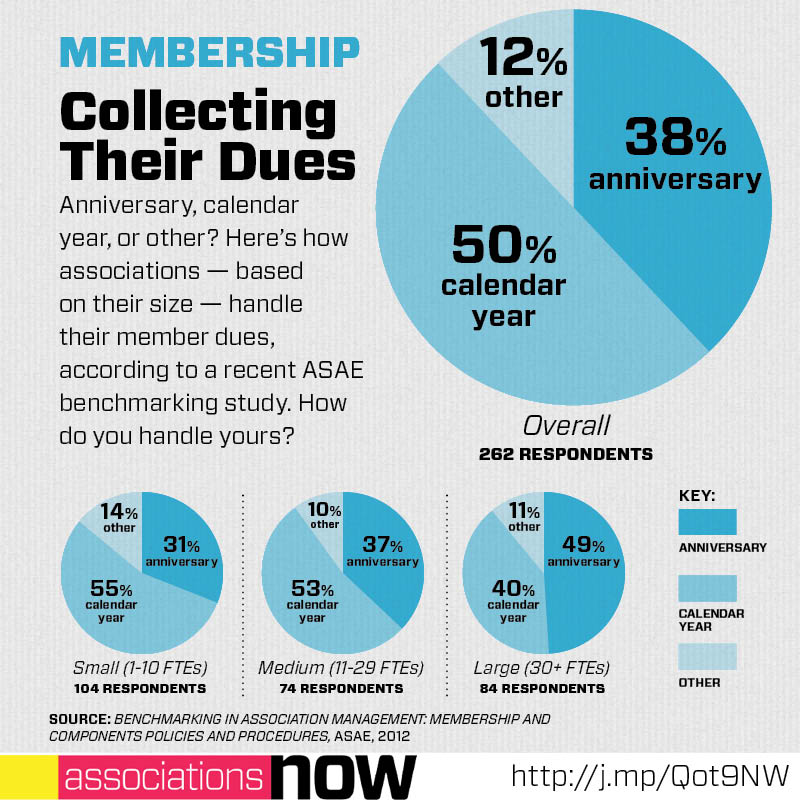
Digging Further on Dues Cycles
Association staff size, member work schedules also key factors in dues cycle choice.
Does your association base its membership dues on a calendar-year cycle or on individual join-date anniversaries? In other words, do your members all renew at the same time each year or throughout the year based on when they joined? Now, whatever your answer is to that first question, do you know why your association chose that model?
In the September/October issue of Associations Now, I shared some data and advice from association pros on this question. (“Membership Memo: Yearly or Year-Round?“) Traditionally, a calendar-year cycle has been more common among associations, and it still is, but anniversary-based dues cycles are gradually becoming more common, particularly among individual membership organizations. Database-management consultant Wes Trochlil posited that technological advances in association management systems (AMS) have made rolling renewals easier to process and thus more likely to be adopted now than in the past.
As more advanced AMS platforms are developed, larger associations with greater resources are the first to adopt them, which may be enabling the shift toward anniversary cycles in that segment.
I also asked Wes why he thinks the calendar model has tended to win out: “I think the calendar renewal is perceived to be easier to manage, because you only have to deal with it once per year. … And it’s easier to manage in terms of labor (i.e., it happens all at once rather than every month of the year) and database management.”
That observation aligns with the breakdown of dues-cycle types by association staff size. A majority of smaller associations use calendar cycles, while larger associations lean toward anniversary cycles.
In past ASAE benchmarking studies, the anniversary cycle has never shown up as more common among any industry segment until this newest edition showing anniversary cycles more common among large-staff associations. Building on Wes’s thoughts, my armchair analysis is that, as more advanced AMS platforms are developed, larger associations with greater resources are the first to adopt them, which may be enabling the shift toward anniversary cycles in that segment.
Should we expect to see that trend continue and trickle down through the ranks of smaller associations, as well? I think so, but the pendulum may only swing so far in the other direction. For some associations, even if anniversary billing becomes easier, it might not make sense for their members. Some industries have natural cycles that put everyone on the same schedule; teachers associations, for example, typically align their membership year to the school year, renewing members on September 1. Accountants are busy in early spring and fall, so AICPA renews members in the summer. And trade associations, in general, have member companies that are likely on similar fiscal years and must plan for member dues in their budgets.
Wes said he also suspects the number of members is a factor: “The typical trade has far fewer members to renew than the typical IMO. For example, one trade I worked for had only 500 members, while some of my IMO clients have 120,000 members. So, if you only have 500 members, there’s not really much to be gained making the switch to anniversary. But if you’ve got 120,000 members, spreading them out over 12 months is probably a lot better than trying to manage them all at once per year.”
So, of course, the anniversary-versus-calendar dues decision is a balance between member needs, staff resources, and technological capabilities. But, if your members don’t all follow an industry-wide schedule, then an anniversary cycle is likely more convenient for them: prospective members can join whenever they want, without prorating, and don’t have to renew for a full year. And as AMS platforms increasingly automate dues billing, anniversary dues cycles may become more and more appealing.
This is my reading of the benchmarking data, but I’m curious what membership professionals see on the ground at their associations. Which model does your association use? Is there a strong reason for it, or is it a “we’ve always done it that way” practice? What challenges do you face in your membership dues billing processes?







Comments